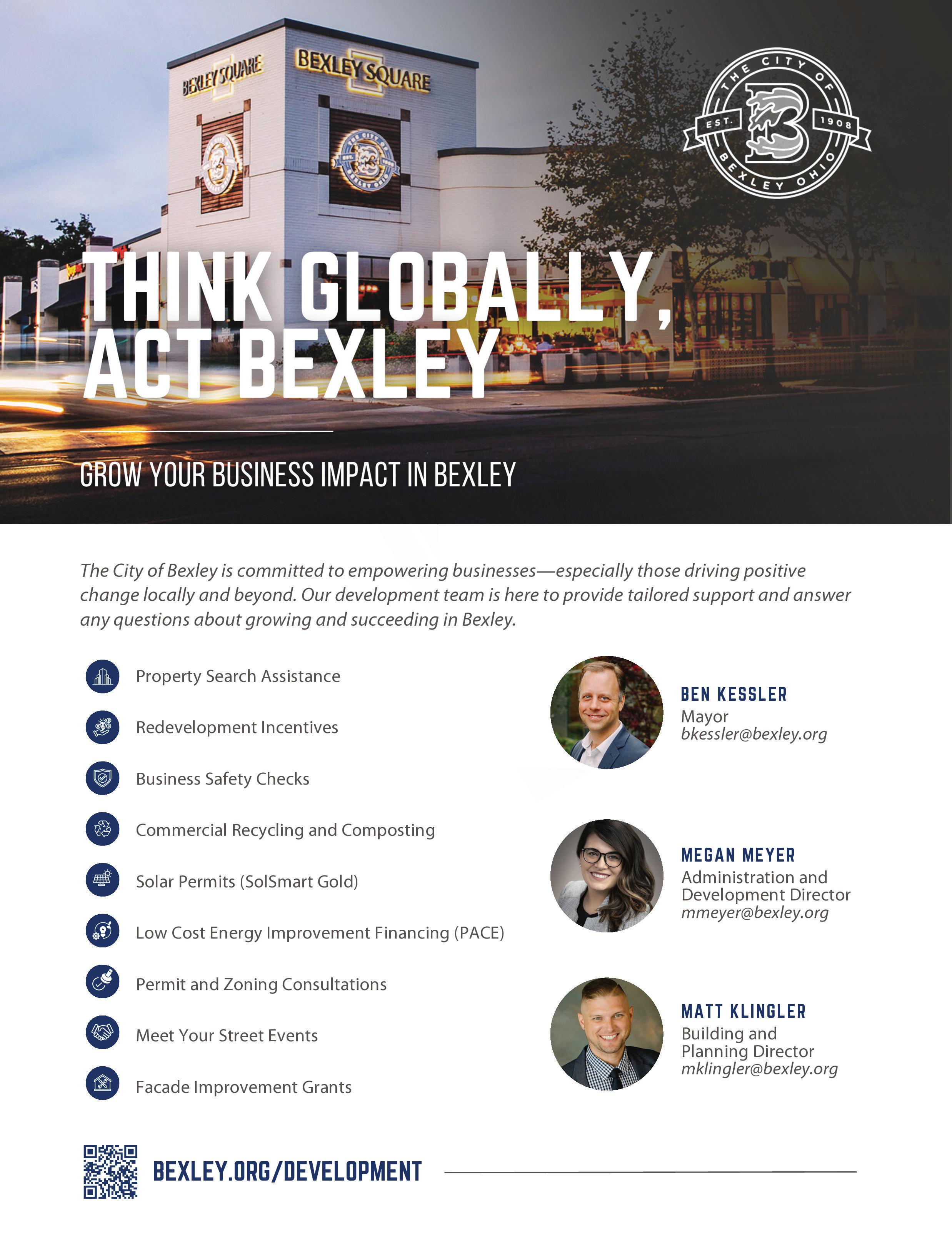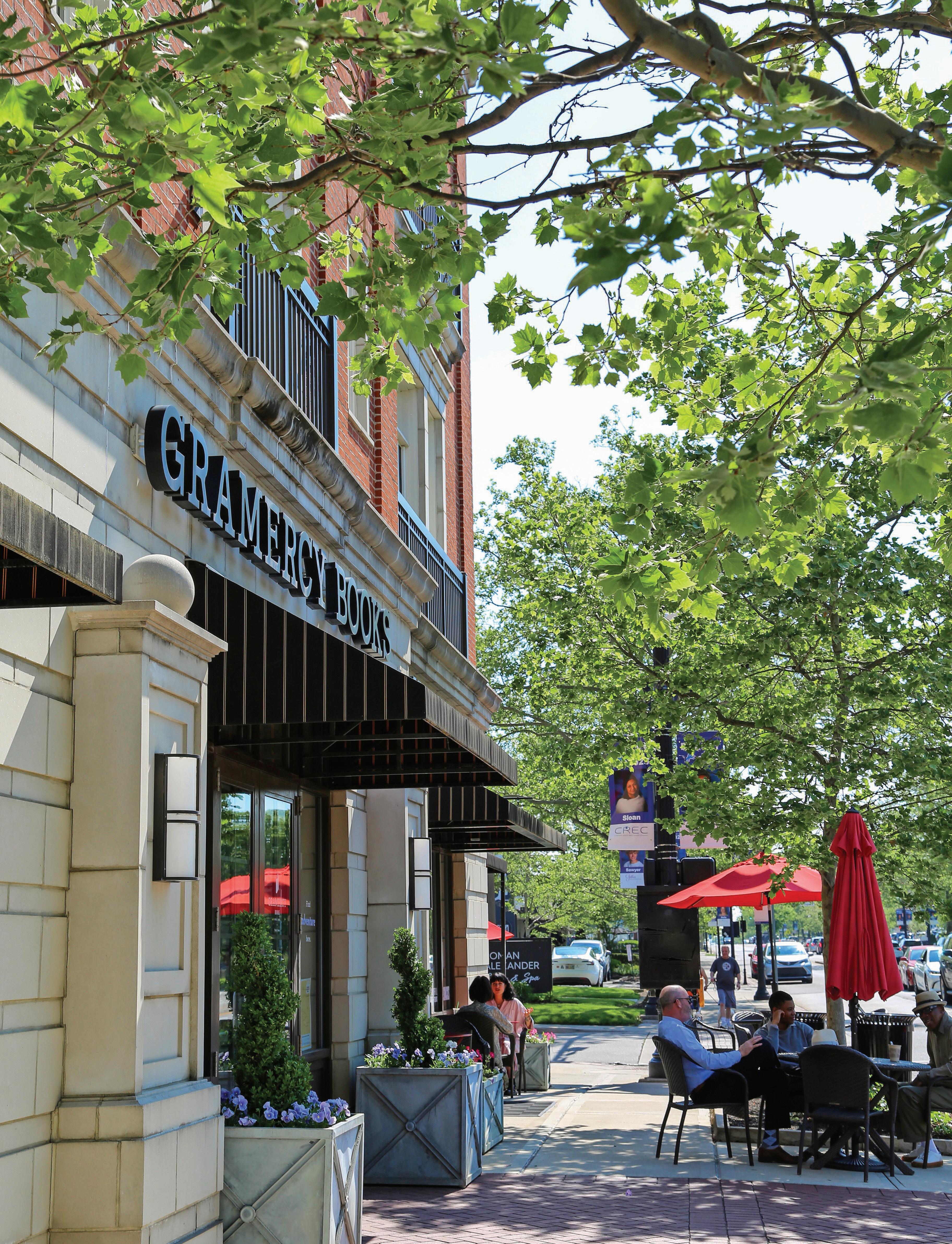

BEXLEY
A SUBURBAN GROWTH SECTION
BEXLEY
WELCOME TO BEXLEY
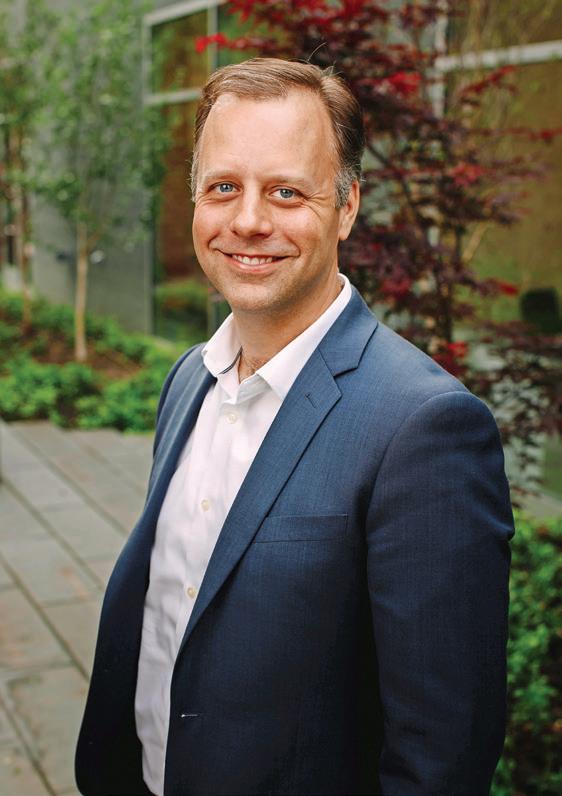
Bexley is well known for our expansive tree canopy, historic and walkable neighborhoods, and nationally acclaimed public schools and library. Our love of lifelong learning is enriched by best-inclass private institutions like St. Charles Preparatory School, Columbus School for Girls and our community mainstay, Capital University. Though just minutes from Downtown Columbus, John Glenn Columbus International Airport and major cultural destinations, Bexley offers the sense of respite and connection found only in a small town.
But what you might not know about Bexley is that while we cherish our deeply rooted history and role as a firstring suburb of Columbus, we’re actively positioning ourselves for meaningful redevelopment as we shape a dynamic and inclusive future. Being fully builtout and landlocked challenges us to think creatively about land use, infill development and adaptive reuse—encouraging sustainable design and architectural innovation while preserving our historic fabric.
Vibrancy on Main Street continues to grow—anchored by regional draws such as the historic Drexel Theatre, Rubino’s Pizza, Gramercy Books and the original Johnson’s Real Ice Cream, and enhanced by new businesses like Katalina’s, COhatch, The Lion and many more.
At the same time, we’re welcoming catalytic projects like The Fitzgerald,
which will add over 230 apartments and much-needed commercial space to the community. We’re also committed to ensuring housing options for all income levels—working with affordable housing developers through the Bexley Community Improvement Corp. to support attainable housing opportunities. Interconnectedness and accessibility are guiding values as we look to the future. We’re working closely with COTA on the East Main Street bus rapid transit corridor, which will raise the bar and define the future of public transit in Central Ohio. Our public spaces are evolving, too—from new murals and community Adirondack chairs (in Bexley blue, of course) dotting Main Street, to major park upgrades like splash pads, a dog park and a new skate park opening soon. (A shoutout to the Bexley Community Foundation for your support of these projects and so much more!)
In Bexley, collaboration with the city and our leaders is personal. We’re small enough to give each new development and business bespoke attention, but bold enough to make a lasting impact. Whether you’re considering launching a business, developing a project or planting roots, we invite you to see Bexley not just for where we’ve come from—but for where we’re headed.
Kessler Mayor of Bexley
GENERAL MANAGER DISPATCH MAGAZINES
Katy Smith
EDITORIAL
EDITOR
Julanne Hohbach
CONTRIBUTING EDITORS
Linda Lee Baird, Lucy Clark
CONTRIBUTORS
Emma Frankart Henterly
Peter Tonguette
DESIGN & PRODUCTION
PAGE DESIGNERS
Kathryn Biek, Kelly Hignite
PHOTOGRAPHY
PHOTO EDITOR
Tim Johnson
ADVERTISING
MULTIMEDIA SALES MANAGERS
Heather Kritter, Adam Trabitz
PRODUCTION DESIGNER
Rebecca Zimmer
MARKETING
MARKETING MANAGER
Lauren Reinhard
PRESS RELEASES
pressreleases@columbusceo.com
ADVERTISING
advertise@columbusceo.com A Columbus CEO Suburban Growth Section
Bexley: A Columbus CEO Suburban Growth Section is published by Gannett. All contents of this magazine are copyrighted © Gannett Co., Inc. 2025, all rights reserved. Reproduction or use, without written permission, of editorial or graphic content in any manner is prohibited. Publisher assumes no responsibility for return of unsolicited materials.
Ben
Photo courtesy City of Bexley

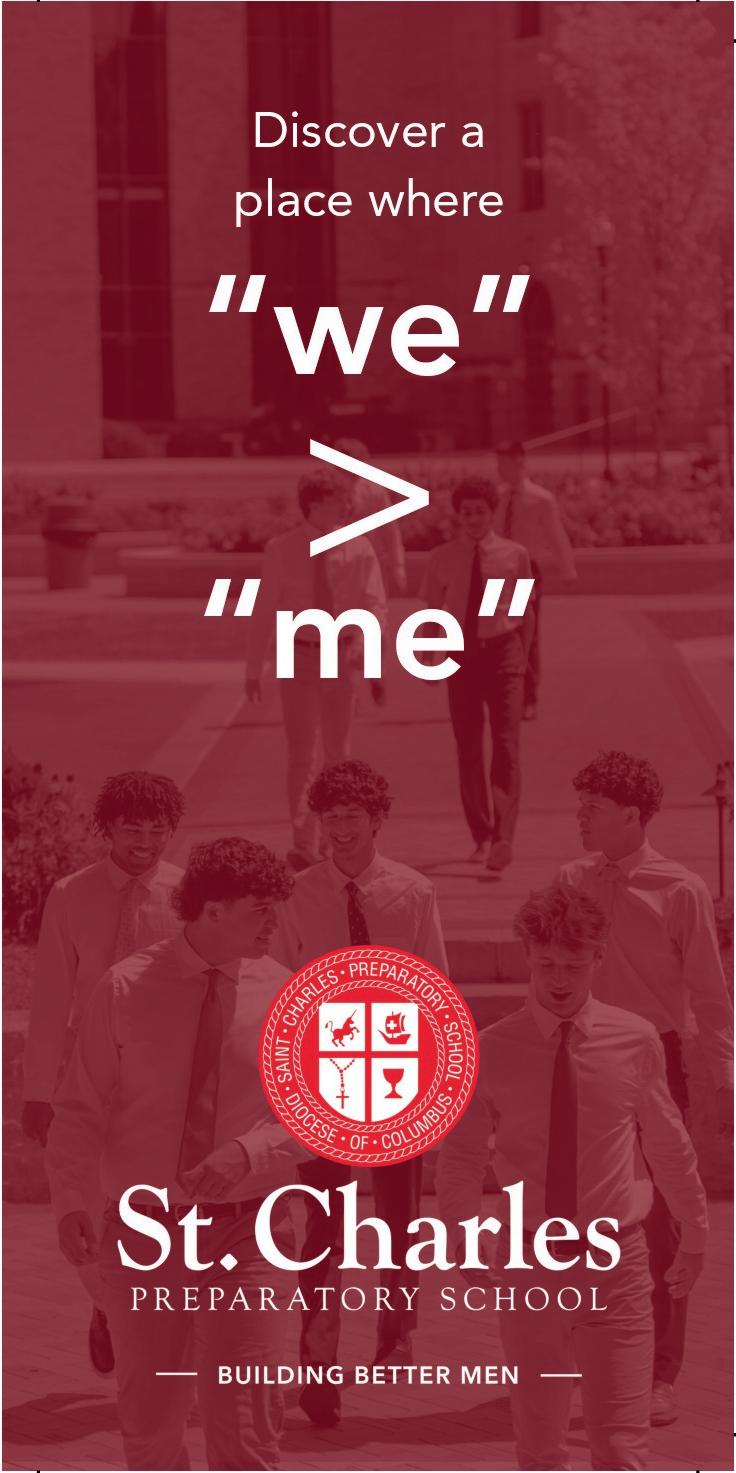

4 OPEN FOR BUSINESS
Bexley is experiencing a development boom, and there’s more opportunity on the horizon.
8 FORWARD THINKING
By focusing on long-term priorities such as sustainability and infrastructure, city leaders are setting the stage for continued success.
12 A CONNECTED COMMUNITY
Bexley aims to bring more businesses and amenities that residents crave while maintaining walkability and homebuyer appeal.

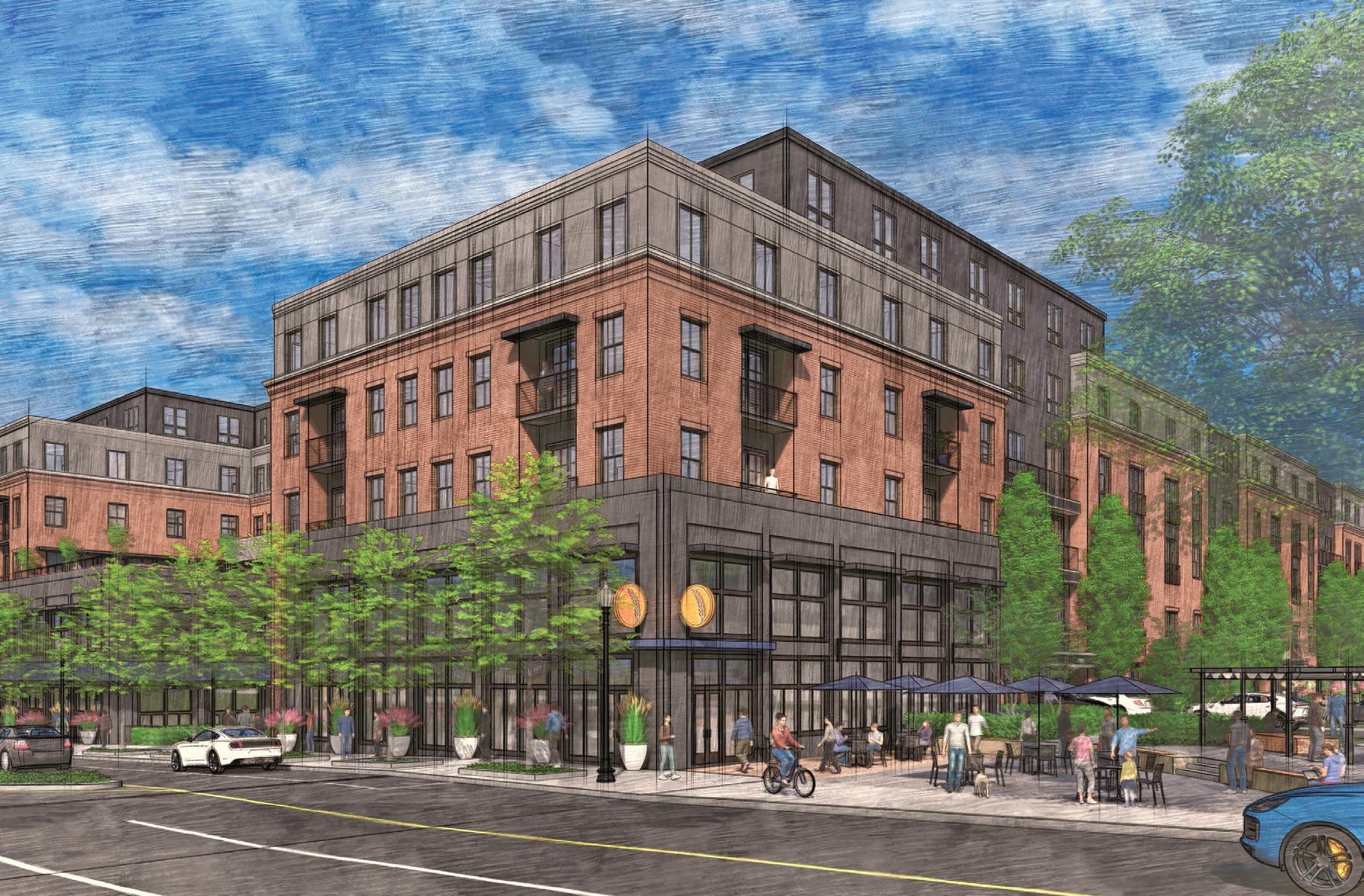
Building New Business
Bexley is experiencing a development boom, and there’s more opportunity on the horizon.
By Julanne Hohbach
Bexley is open for development, and city leaders aren’t shy about sharing that message. From a recent resurgence of businesses on East Main Street to a new mixed-use project from noted local developer Frank Kass, the scene is far from stagnant.
“We’re not just a sleepy bedroom community. There is opportunity here,” says Director of Administration and Development Megan Meyer.
Though the city isn’t blessed with an abundance of available land like many of its suburban counterparts, officials say that doesn’t mean there’s no room for business growth. In fact, it’s just the opposite.
Meyer says that careful planning efforts, including an updated Land
Use Strategy, will help the city provide new opportunities as parcels become available. “We can help guide what the future of that looks like from the city perspective and make sure that we’re staying aware of historic preservation and walkability and connectivity while also responding to what residents want,” she says.
The original 2011 Main Street recommendations included moving City Hall into the old Bexley Monk space and replacing it with a Market District grocery store. They also spurred creation of the Bexley Community Improvement Corp., as well as a strategy to remediate vacant gas stations—a goal Meyer says the city will accomplish within the next two years.
“Since 2011, the game has really changed for Bexley. The market in Central Ohio is no longer for office. We’re really seeing a boom in the need for new housing, and our updated strategy recommendations understand that. We understand, too, that there is a desire from our residents for amenities and services close to home,” she says.
“For us to make that happen in Bexley, that does mean we need to strategically plan to redevelop, and so that’s the goal of this plan is to identify areas where that is a best fit and to guide the way for that redevelopment.”
A Vibrant Main Street
Despite its modest 2.5-square-mile footprint—the city is bounded by Alum
The southeast corner of The Fitzgerald development
Creek, Delmar Drive, Gould Road and Livingston Avenue—the business scene continues to grow. Newer tenants on East Main, including Katalina’s and COhatch, complement longstanding businesses such as Gramercy Books, Urban Emporium, Giuseppe’s Ritrovo and Cherbourg Bakery, which sits just around the corner on South Drexel Avenue. “What we’re seeing … are creative, adaptive reuses of sites,” Meyer says, which increase the overall vibrancy of Main Street.
Officials say the key lies in thoughtful redevelopment projects. In recent years, the city has encouraged developers to create multifamily housing above restaurant and retail spaces.
One such project is the under-construction, mixed-use development at 2200 E. Main St. known as The Fitzgerald. Developed by Kass’ Continental Development Ventures on the site of the former Trinity Lutheran Seminary apartments, which had been owned by Capital University, city leaders hope the project is indicative of the type of development to come. The Fitzgerald will include about 230 apartments, more than 12,500 square feet of office space and 11,000 square feet of retail and restaurant space, including a new location of Hudson 29 by Cameron Mitchell Restaurants.
“The Fitzgerald is a wonderful proof of concept of how you can get creative in Bexley,” Meyer says. “The Fitzgerald is truly illustrative of what our code allows and exactly what type of quality redevelopment Bexley is looking to do into the future.”
Kass, a Bexley native, has undertaken two other significant ventures in his hometown: the Market District-City Hall project and the Gramercy Building. “Bexley is the quintessential urban inner ring suburb that you don’t find empty land and empty lots. You have to redo something,” he says.
The developer says he’s been happy to contribute to economic development in the city. “Main Street has just developed beautifully,” Kass says.
“[Bexley is] just a great place to live. The housing market is strong because of the schools, in part, because of the trees and the neighborhoods where the houses don’t all look alike, and you’re close to everything, whether it’s the
airport or Easton or Downtown.”
Gramercy Books founder and owner Linda Kass is among the small business owners who have found success here. Her shop is on the ground floor of the building where she and her husband, Frank, live.
She praises the city for the work it has done creating parking and the landscape islands that slow traffic while enhancing aesthetics, which benefit all Main Street businesses.
Linda Kass says the city is an ideal location for Gramercy because the community places a high value on education. The bookstore is able to partner with the Bexley Public Library and other businesses, including the Drexel Theatre and Giuseppe’s Ritrovo, for its author visits.
“I think it’s really special to have a local bookstore in a community because it is another gathering place, and I think that Bexley is such a special community itself. There’s just so many things
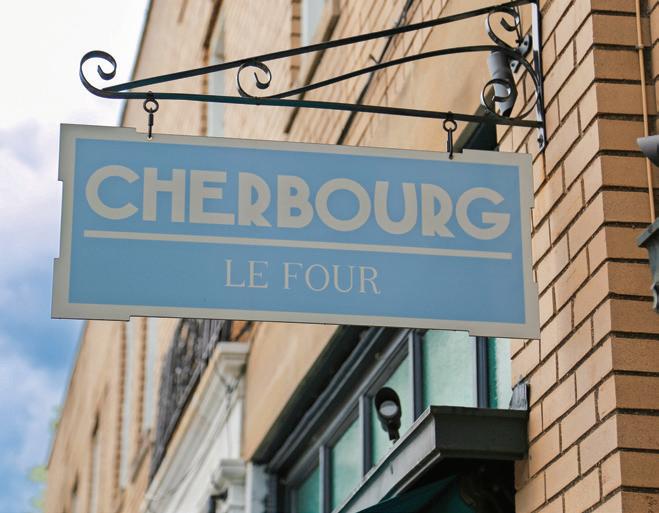
that exist for families and residents to partake in that it’s another addition to that very special milieu that is Bexley,” she says.
Support System
The city makes a concerted effort to support both new and existing businesses, including through a façade improvement grant program. Its efforts are complemented by the Bexley Area Chamber of Commerce. Executive Director Bryan Drewry says his organization aims to aid businesses with a variety of needs, including helping them find space, offering promotion and support, providing money-saving programs and creating a robust programming lineup, including a breakfast series, happy hour and women in business events. “We’re really trying to be very proactive with our businesses,” he says.
In May, the chamber, the city and the Franklin County Board of Commissioners partnered on a new Ignite Growth economic summit for the east side of Columbus. The goal, Drewry says, was not only to help businesses gain important insights, but also for local officials to learn about the challenges facing these companies and to find ways to support them.
The chamber also created a new initiative to help businesses with needs such as equipment and storefront improvements. In its first year, it bestowed two awards totaling about $7,000. “We
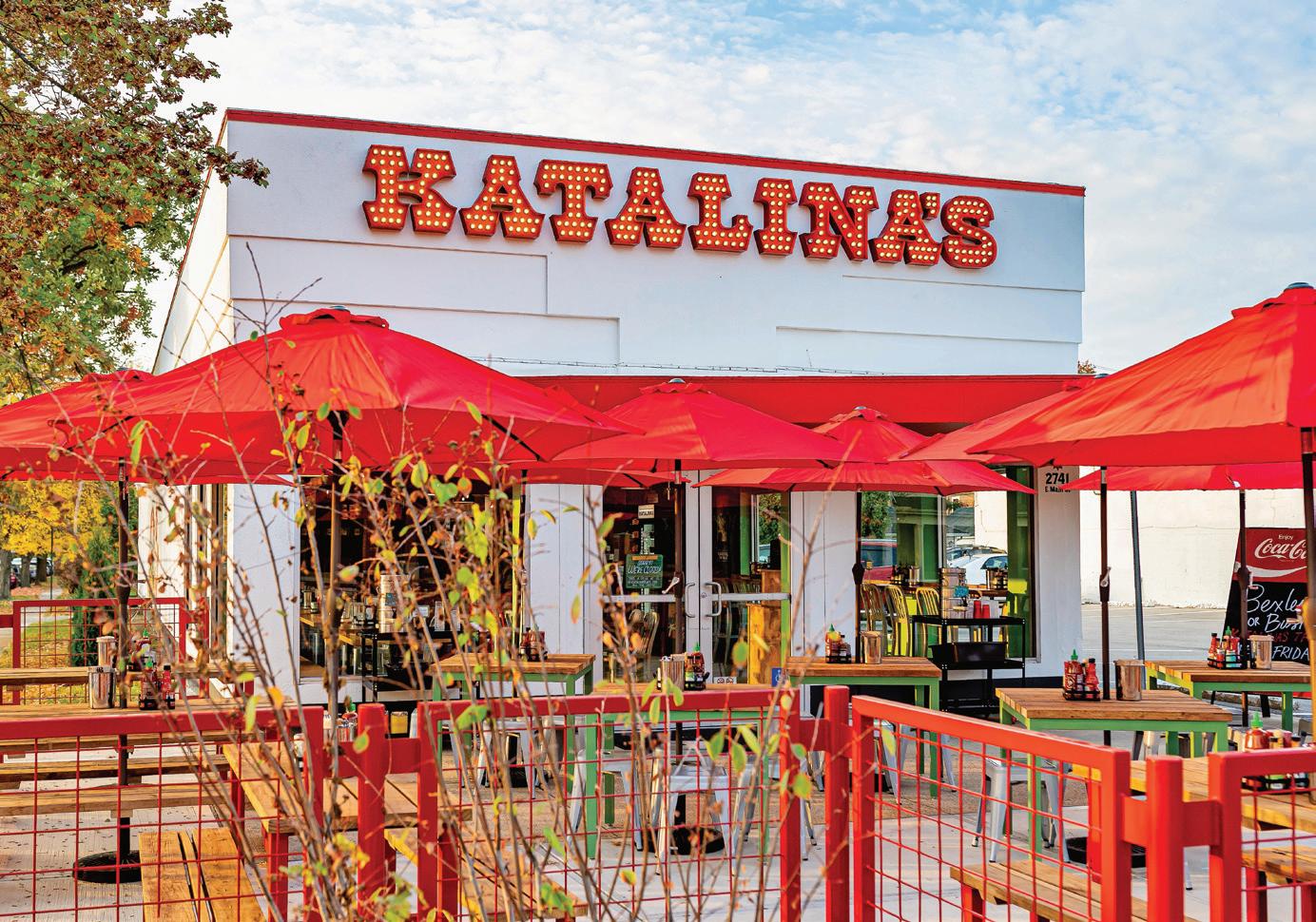
Katalina’s on East Main Street
Cherbourg Bakery
Photo courtesy Raquib Ahmed
BEXLEY
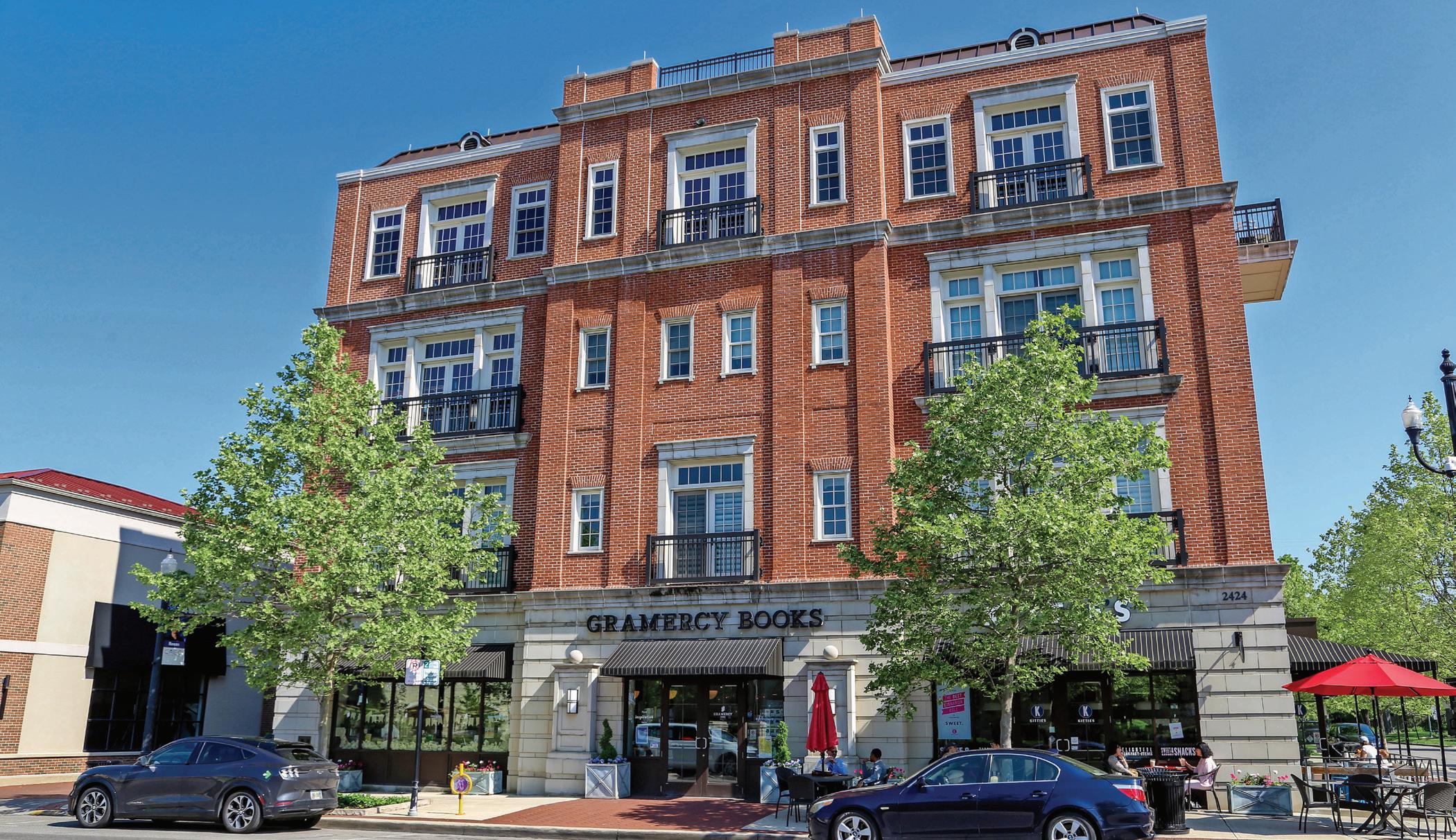
gave them money as a grant program to help them increase their business,” Drewry says.
On the Horizon
As Bexley officials look to the future, one possible area of growth lies on university-owned land along Alum Creek, away from the core campus. “We’ve been in discussions there with what [do] the city map or long-term plans look like,” says Capital President Dave Kaufman, who will conclude a five-year tenure when he retires at the end of July. “There could be some interesting opportunities with that land.
“There’s things looking five to 10 years out that potentially could benefit both Bexley and Capital,” he says. “If you look at our updated footprint, we’ve identified that for potential development.”
Kaufman says since he arrived at Capital in 2020, the school has enjoyed a strong relationship with the city, and he and Mayor Ben Kessler talk regularly. “We’re good neighbors both ways,” he says. “We’ve kind of had an informal principle that whatever happens on Main Street is in [the] best interest of both of us.”
After all, development on Main Street
benefits Bexley residents, as well as Capital faculty, staff and students. And the university itself is an economic driver. When coming to Capital, Kaufman considered its economic impact on Central Ohio. “There was a study done a few years ago, and it came out to be about $170 million a year … so Capital is a significant contributor to the local economy,” he says.
The city and Capital partner on community events, including hosting the Fourth of July celebration on campus, and the university works with Bexley City Schools on shared athletic fields and other efforts, Kaufman says. “It’s been a really, really strong partnership.”
Beyond possible development opportunities with Capital, several other projects are on the horizon for the city, including redevelopment of the former gas station at Chelsea Avenue and East Main. Meyer says the city is working collaboratively with the owner to remediate the site. “We’re looking to the future to have that site be a welcoming, and I think better-fitting, entrance to Bexley for those traveling west,” Meyer says.
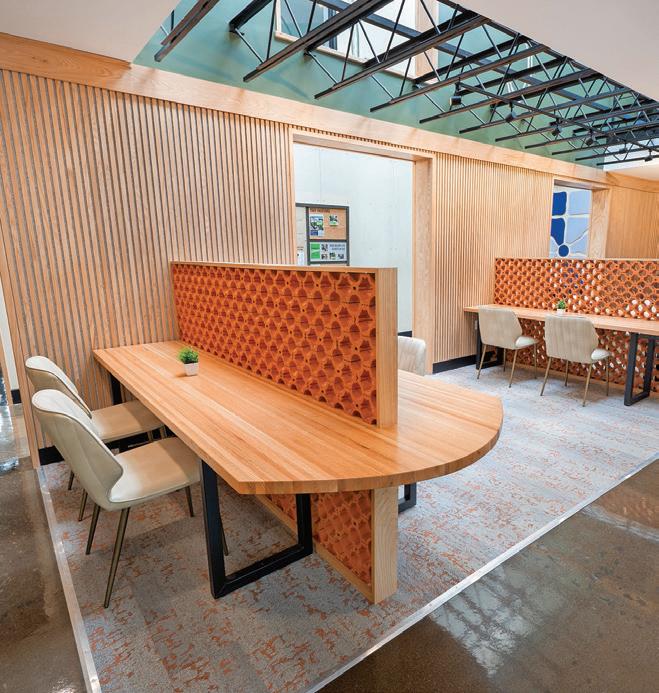
Progress is happening on the city’s northern end, too. “The Bexley CIC has acquired property on Cassady Avenue and is working to redevelop that corridor as thoughtfully as we are developing parts of Main Street, recognizing that that is a major drive-through for people,” Meyer says.
This will include streetscape improvements and potentially restaurant or retail spots, in addition to a mixeduse development featuring affordable housing and a new senior center.
“We are trying to drive more foot traffic and business to all of our commercial corridors, not just Main Street, to strengthen the vibrancy of all that we’ve got, whether that’s Cassady, Main or Livingston,” Meyer says.
The Gramercy Building
COhatch


































































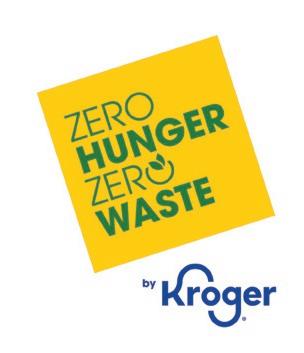
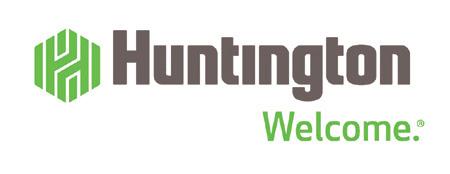


BEXLEY

Forward Thinking
By focusing on long-term priorities such as sustainability and infrastructure, city leaders are setting Bexley up for continued success.
By Emma Frankart Henterly
No one can predict the future, but with careful planning, Bexley’s city leaders, business owners and residents are shaping a promising tomorrow for themselves and generations to come. Sustainability and accessibility serve as throughlines for nearly all of Bexley’s plans, with forward-thinking initiatives that address everything from climate change to population growth.
Leading by Example
Bexley is no stranger to “green” innovations: According to city leaders, it was the first community in Central Ohio to offer citywide curbside service for recycling (1990) and composting (2019). The city began purchasing renewable energy to power facilities, streetlights
and traffic lights in 2017—the same year it announced the Bexley Zero Waste Plan, a long-term strategy to reduce landfill use by 90 percent by 2040.
“We hope to see more cities prioritize environmental sustainability,” says Sustainability Programs Coordinator Elizabeth Ellman. “We feel it’s a team effort, and it’s something that we are all compelled to do.”
More recently, Bexley launched a universal recycling program that requires commercial, institutional and multifamily properties to have a recycling contract, which the city helped negotiate. The rate, Ellman says, is lower than what many organizations could have secured on their own.
And in 2025, the city renewed its
electric aggregation contract with Dynegy to supply affordable clean energy for residents through their existing service provider. Electric vehicle support is also a priority, with new EV charging stations at Schneider and Jeffrey parks and Drexel and Cassady avenues, joining three already installed at City Hall.
“Right now, we are working on a Sustainability Action Plan to encapsulate the goals we already have and more,” Ellman says. “We’re trying to take a broad view of many aspects of sustainability and funnel it down … to make this plan as user-friendly as possible.” The document incorporates community feedback and more will be sought later this year before being presented to Bexley City Council for approval.
The Bexley Farmers Market is a mainstay of summer.
“Many residents desire to help take care of our planet and those living on it; there’s additional camaraderie among neighbors who participate in our programs and a sense of community helping each other,” Ellman notes, citing as examples resident-led initiatives such as Love Your Alley, a code-enforcement-turned-native-plant-education program, and Circular Thrift, which focuses on reducing textile waste through mending, recirculation and recycling.
Businesses are getting in on the action, too. This year, Kittie’s Café and Swonderful Times Café joined the Okapi Reusables coffee cup rental program. Sustainability is a passion for Kittie’s owners Steve and Diane Herman, so when the Central Ohio Reuse Coalition contacted them about partnering with Okapi, “it fit right in with what we do,” Diane Herman says.
Participants can borrow up to two cups for up to two weeks at a time before returning them to any participating business—currently seven in Central Ohio—to be sanitized. “It’s a really nice program to help encourage people to reuse,” Herman says. “Our planet, our communities—it’s everyone’s responsibility.”
This mindset in Bexley starts young, with an education program that Ellman describes as “one of the most impactful ways we make a difference.”
Each month, 500 students in grades 1, 4 and 7 learn about a different aspect of environmental sustainability.
“Youth will be the most impacted by the climate crisis,” Ellman says. “They deserve to know how to build a more sustainable future for themselves.”
Safety and Accessibility
At just under 2.5 square miles, Bexley is primed for walkability—and city leaders prioritize it in infrastructure projects.
“We’re installing medians to make a more walkable and bike-friendly community,” says Service Department Director Andy Bashore. “Even our [traffic] lights on Main Street, I have them set to max out for pedestrian crossings.”
Safety is paramount, and Bashore is also installing rapid flashing beacons and orange crossing flags at unprotected intersections used by children walking to school.
Wayfinding signage is a key goal for bikeability, Bashore notes; Ellman adds that the 2021 Bike Friendly Bexley plan also recommends education and infrastructure like increased parking, fix-it stations, pavement markings and more.
While new initiatives tend to get the most attention, Bexley doesn’t let less-glamorous aspects of future planning fall by the wayside. Bashore notes that annual infrastructure projects
proactively tackle upkeep for streets, sidewalks, sewer lines and more.
Other efforts, such as the Joint Livingston Avenue Plan—a partnership with the City of Columbus to improve aesthetics and driver and pedestrian safety along a busy corridor with high accident rates—focus on immediate infrastructure improvements and future development plans to ensure accessible roadways.
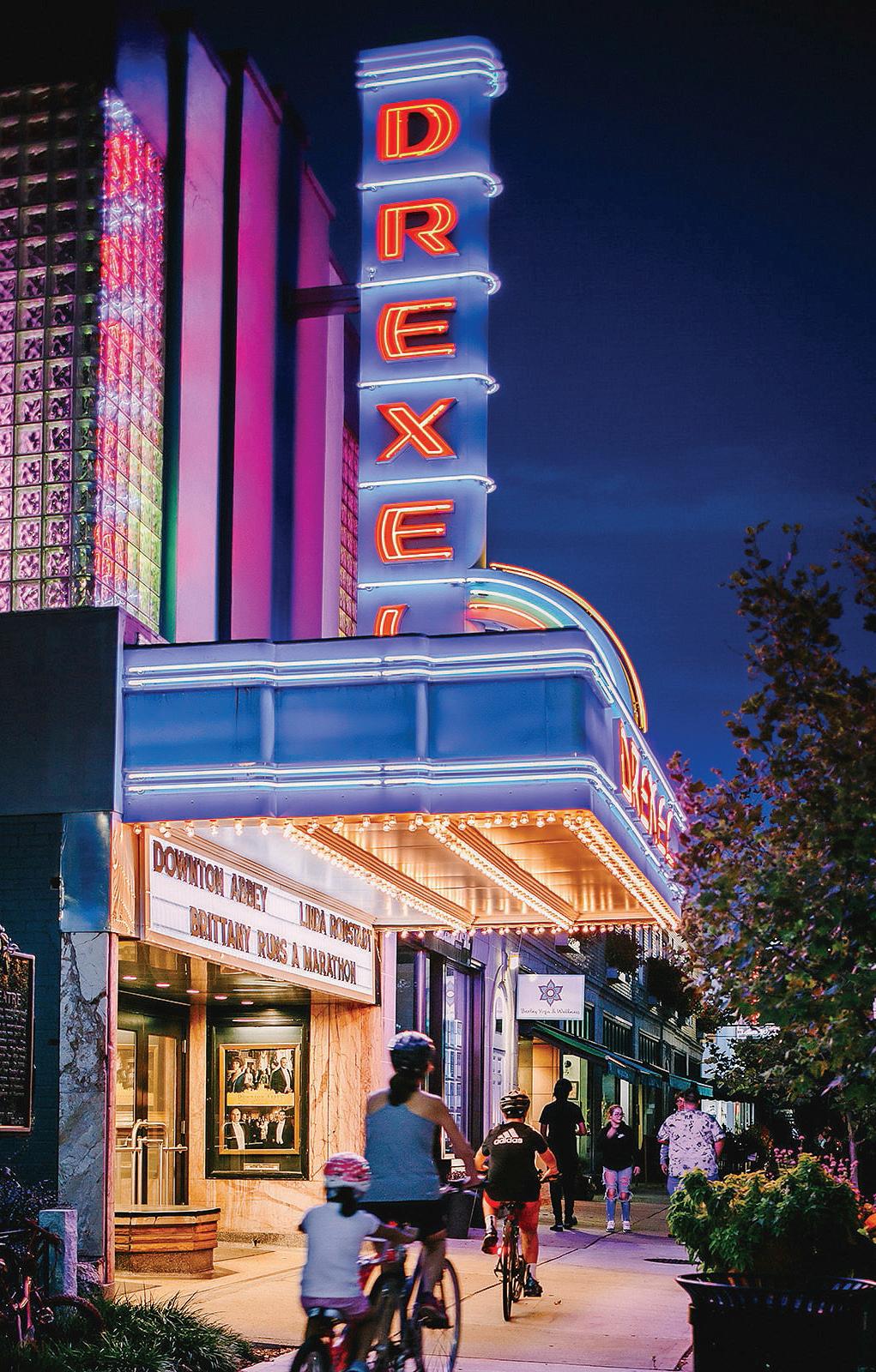
Bicycle riders pass by the Drexel Theatre.
BEXLEY
Moving Forward, Together
Bexley isn’t content to work in a silo when it comes to accessible public transportation, either. In November 2024, 68 percent of its residents backed Issue 47, the sales tax levy whose passage will support Central Ohio Transit Authority expanded operations and fund a new regional LinkUS transit plan.
LinkUS “represents a transformative investment in transit,” says Bexley resident and COTA board of trustees member Kumi Walker, who notes that the region’s desirability and resulting population increase call for a proactive approach. “Transportation and housing are really important things to invest in ahead of growth … so we can avoid or at least mitigate some of the affordability challenges that loom ahead.”
Among other service and infrastructure improvements, LinkUS will introduce five new bus rapid transit lines with traffic signal priority; high-capacity, zero-emission vehicles; dedicated
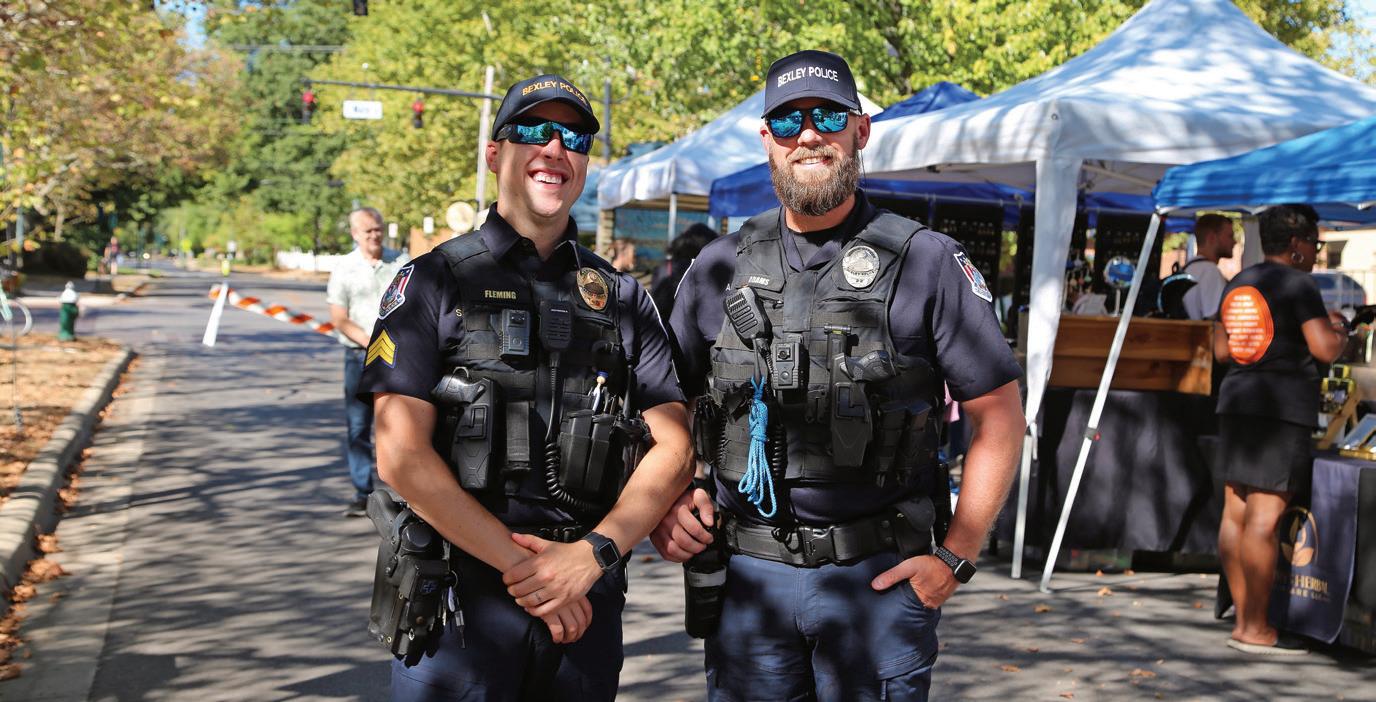
transit lanes and more. In Bexley, the city’s East Main Street corridor will be upgraded with a BRT station.
“You can’t really use transit if it’s not reliable,” Walker says. “At COTA, a big thing that we’ve talked about a lot is ‘moving every life forward.’ ” He notes that while not everyone relies on COTA to get around, plenty of Central Ohioans do—and increasing ridership
has benefits for non-riders in the form of reduced roadway congestion and parking demand.
“Great transportation—you feel it if you’re in a community that has it, and you especially feel it if you’re in a community that does not,” Walker says.
“At its core, it’s about access; it’s about affordability; it’s about making sure that everyone has opportunities.”

Stay up-to-date with Columbus CEO’s mobile-friendly newsletter. Delivered straight to your inbox every other week, Columbus CEO Insider has the latest Central Ohio business news, executive profiles and happenings.
Bexley police at a community event
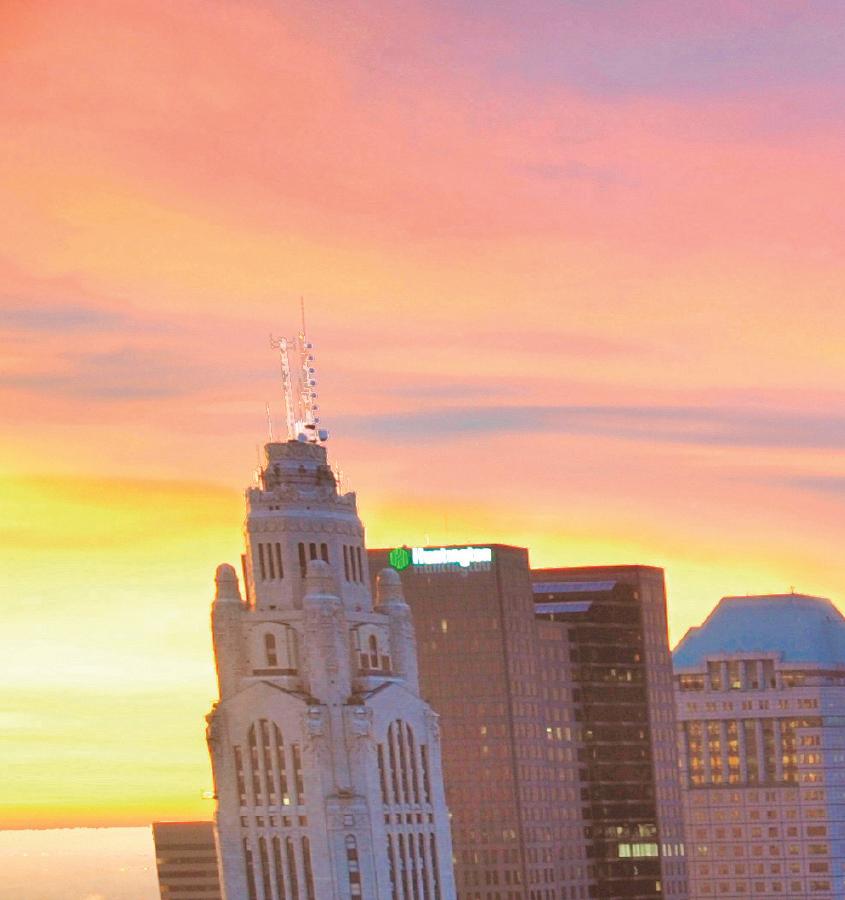
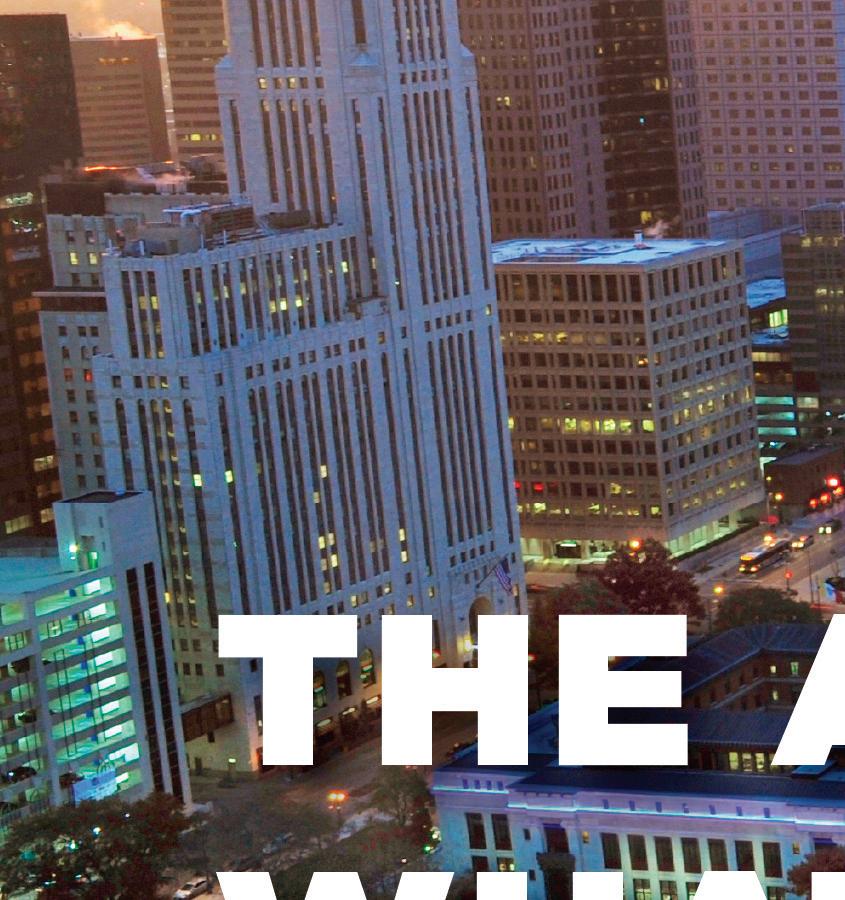
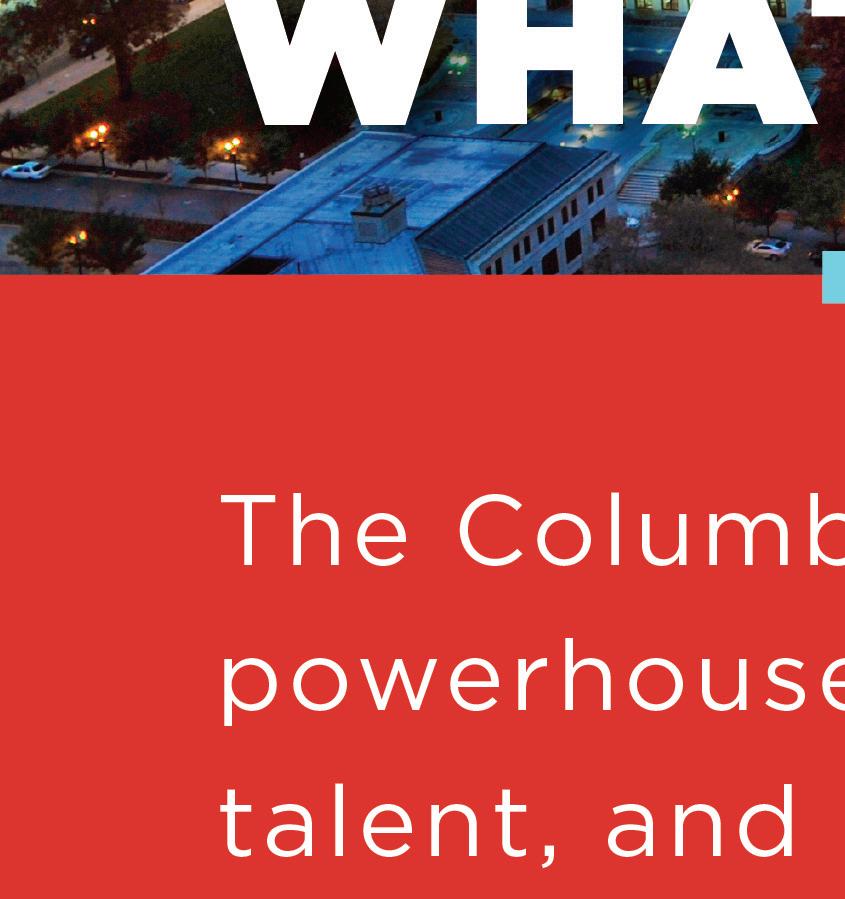

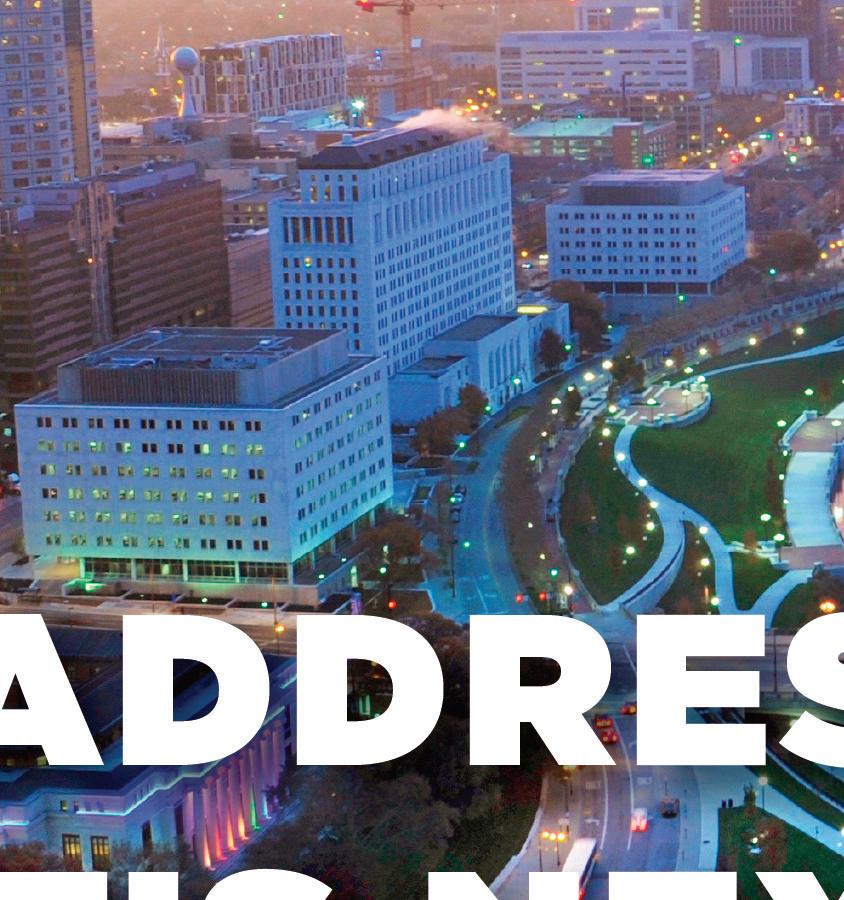
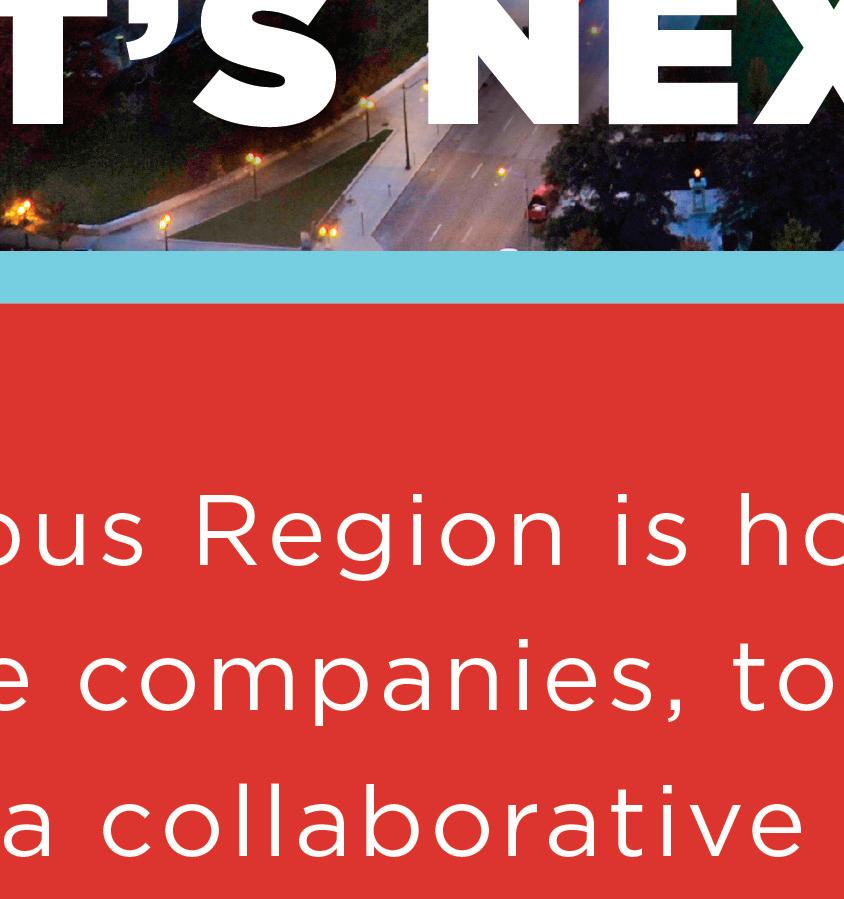
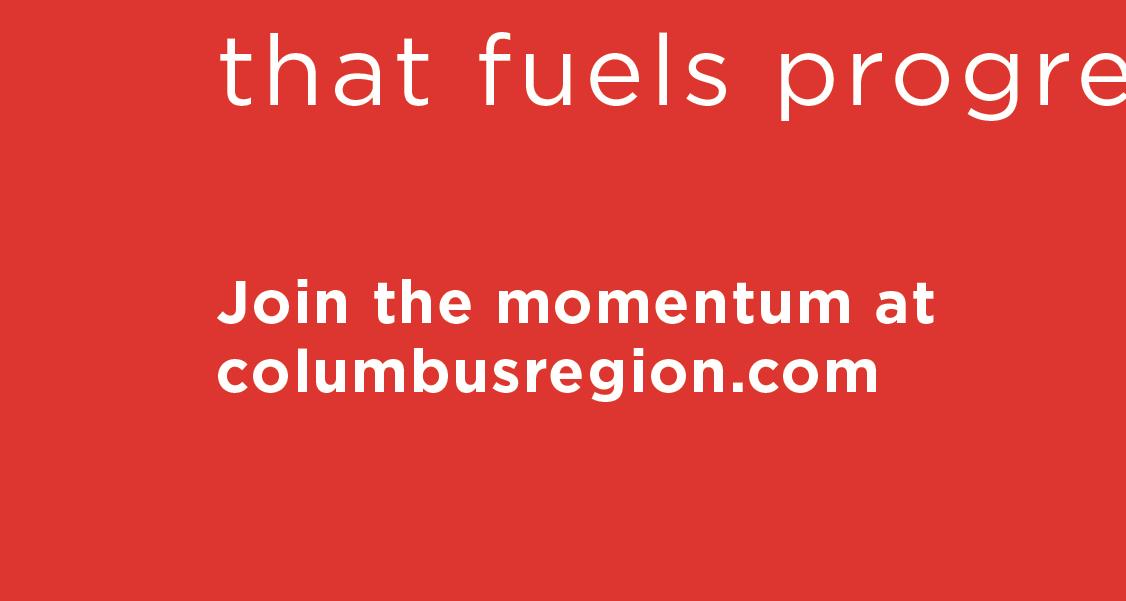


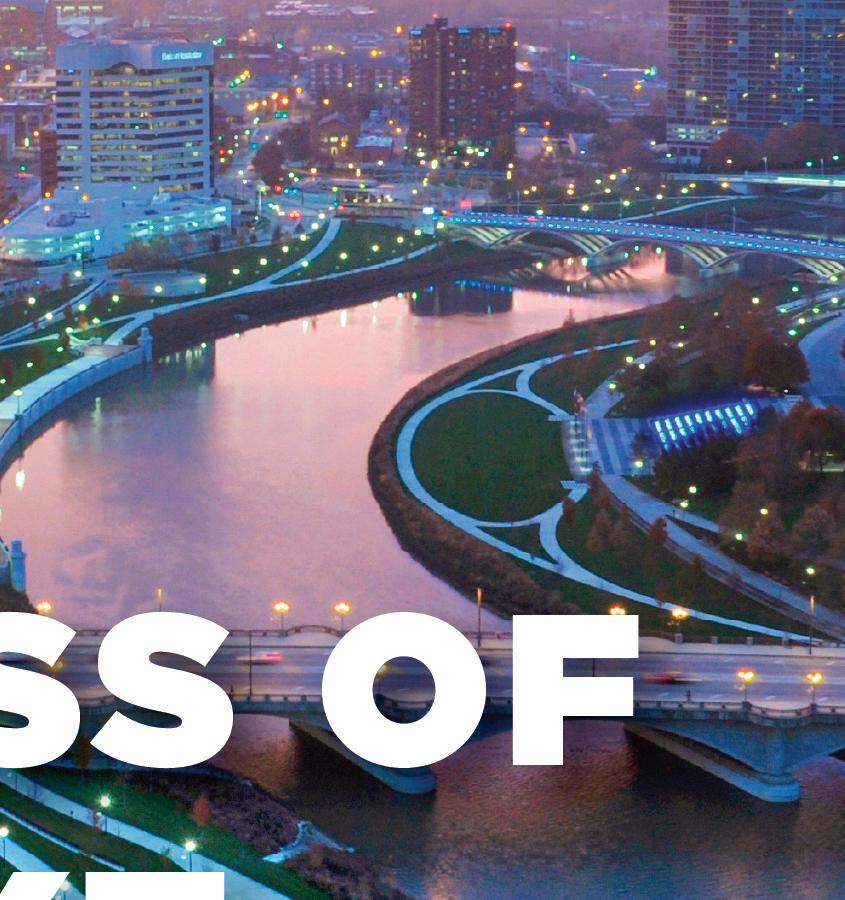
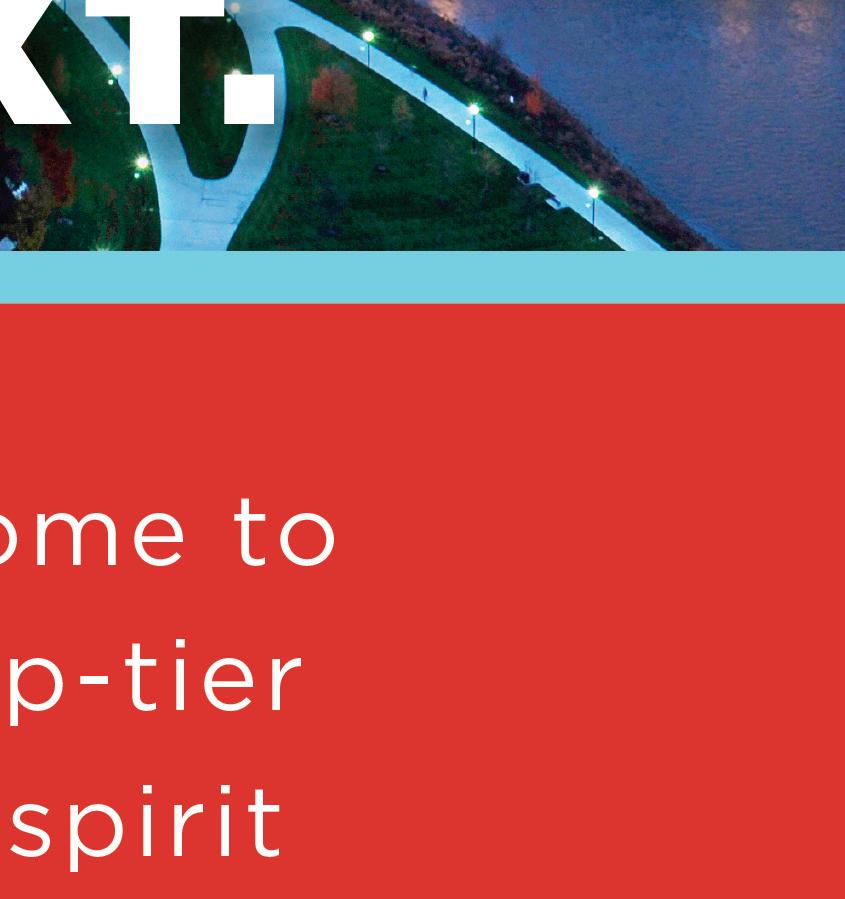



Community Connections
Bexley aims to bring more businesses and amenities that residents crave while maintaining its beloved walkability and homebuyer appeal.
By Peter Tonguette
When Mike Davis moved from New York City to Bexley in 2020, he had a mostly favorable impression of the Central Ohio suburb: It was a wonderful place to live and work, but perhaps lacking a sense of its own potential for economic development.
“I kind of quickly realized there wasn’t much to do in Bexley past 9 p.m.,” says Davis, who saw an untapped market for commercial expansion that could capitalize on the city’s best qualities, especially its dense population and walkability.
“I think Bexley is going through this reinvigoration,” he says. “I looked at that and said, ‘I need to scratch my own itch and create something that I would like to go to.’ ”
Four years later, Davis—the co-owner of Bexley Hospitality—opened The Lion, a cocktail bar that doubles as a coffee shop. “Things are going great,” he says. “What we thought about the community—the people that live here, this pent-up demand—is kind of coming to fruition.”
The success of The Lion, which opened its doors in September 2024, is just one example of how Bexley is growing and evolving to meet residents’ needs. Not content to rest on the city’s reputation and unique heritage, leaders work hard to position it as a place that draws newcomers, residents and businesses alike.
Mayor Ben Kessler touts the city’s “knowability.” “It’s a human-scale
city,” Kessler says. “You can know your neighbors. You could go out into the community, you can bump into people in the grocery store. … It’s large enough that you’re going to find a social group that works for you. It’s small enough that you feel very connected and a part of that community.”
Kessler says officials have been intentional about redevelopment, especially given the city’s compact size and limited business space. “Along Main Street, along North Cassady and along Livingston, on our southern border, are the areas where we have capacity for commercial redevelopment,” he says, noting the city is working on an update of its 2011 Land Use Strategy plan.
Local leaders would like to fill specific
Children at the Fourth of July parade
gaps in the commercial sector, notably in health care. “We want to get much more intentional on encouraging a medical office in Bexley,” Kessler says. “You could say we’re in a little bit of a desert as it pertains to primary-care providers, OB-GYN and pediatrics.” He also sees a hunger for small co-working spaces, as well as additional sit-down restaurants; market research suggests that three more could be added.
Many such ideas are developed at the ground level. “It goes as granular as we hear from a lot from residents who would love a Mexican sit-down restaurant,” Kessler says. “We are subtly and actively trying to figure out how we can match-make that sort of a space.”
Kessler and others would like to add to the city’s retail sector, whose growth has historically been limited by the abundance of institutional land users, including Capital University, schools and places of worship—a strength of the city but also a challenge in redevelopment. “You have this burst of retail energy on one side of [East Main Street], but across the street is a much more passive zone,” he says. “We’re always trying to figure out how we make this more continuously active.” Going forward, he would like to see commerce on both sides of the street. “It’s always going to be small for now,” he says. “It’s going to be a little more boutiquey.”
One thing that won’t change, however, is the city’s grid layout, which is attractive to both business and residents because it encourages foot traffic throughout Bexley. “That grid really does reinforce the connectedness of the community,” Kessler says.
Going Beyond Curb Appeal
Bexley has long been a sought-after destination for homebuyers, not only for the quality and mix of housing options but also the city’s efforts to create an attractive, livable community. It is a 35-year Tree City USA participant, and in 2013 it became the first municipal arboretum accredited by the Morton Register of Arboreta.
“Bexley is certainly a unique opportunity for someone who doesn’t want to live in a huge city, who wants a good school system, who wants to live in an arboretum, who wants to live in a community where we believe in helping

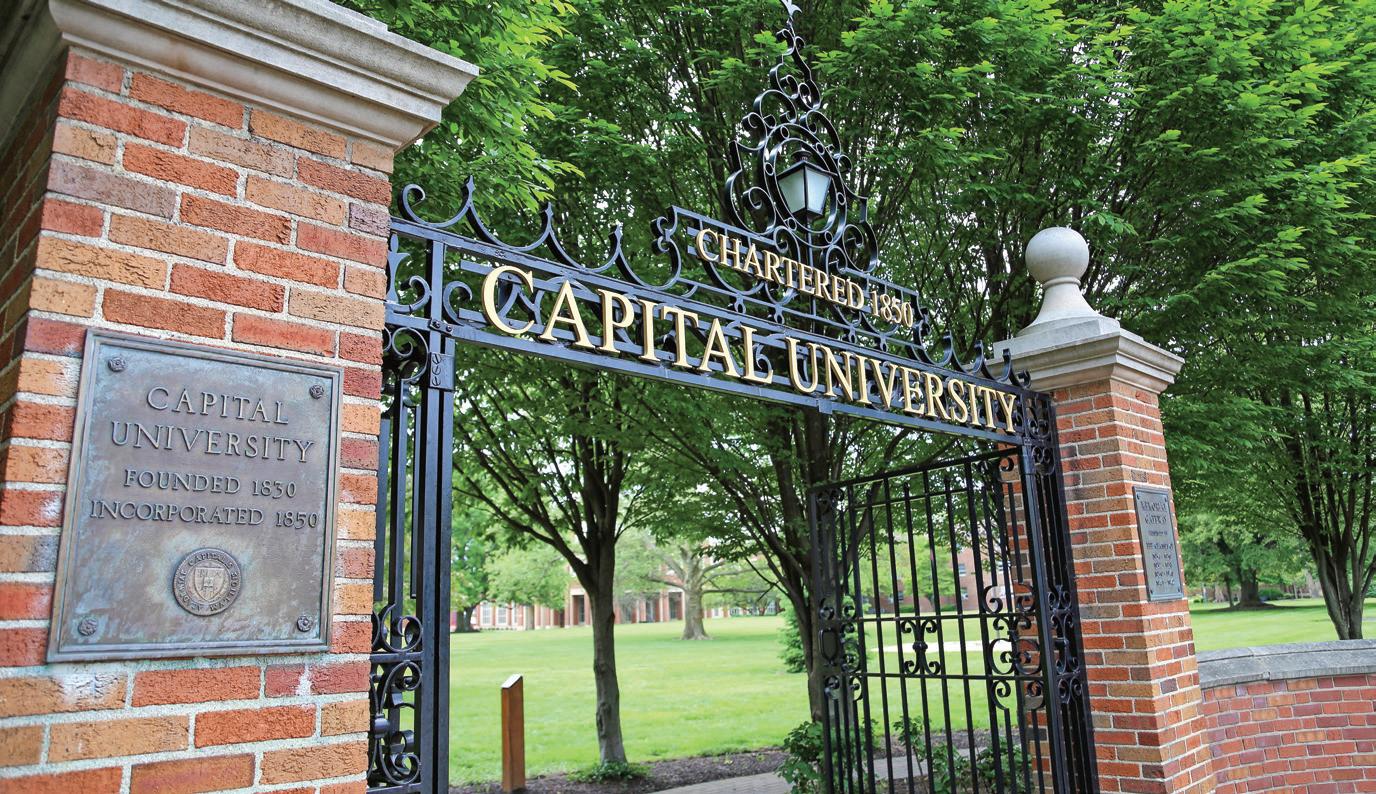
the environment,” says Realtor Sheila Straub of Coldwell Banker Realty, who is also the chair of the Bexley Community Foundation.
The city’s educational abundance, including Capital, Bexley City Schools, Columbus School for Girls and St. Charles Preparatory School, is one of its most distinctive attributes. “That is always going to be one of the core cornerstones of what drives the appeal of our Bexley community,” Kessler says.
Jason Fine, superintendent of Bexley City Schools, cites the importance of a supportive environment that is welcoming to all. “People here genuinely look out for one another, and that spirit shines in our schools and beyond. We often talk about being champions of curiosity, kindness and equity—and what’s remarkable is how those values show up not just in classrooms, but in every
corner of the community.”
The mature and well-maintained real estate stock is an undeniable attraction. “Houses are close together enough that you can really get to know your neighbors, and [they] have real architectural integrity to them and patina,” Kessler says. “You can’t just up and build a community that has the historic character from scratch.”
Even so, leaders aim to make living in Bexley more attainable through the city’s first-ever affordable housing permits, encompassing one development across two sites on North Cassady and East Livingston avenues. The Community Builders Inc. and the Bexley Community Improvement Corp. are partnering on the project. Although the apartments will be open to all age groups, the expectation is that the oneto three-bedroom residences will appeal
The Capital University gateway
An artist at work during Mural Fest
BEXLEY
to senior citizens. “They are going to be much more affordable to someone than a mortgage on a single-family home in Bexley,” Kessler says. “We see that as another way that we can help broaden the entrance to the community.”
Increasing socioeconomic diversity is a priority in the city. “We want to make sure that we continue to be accessible to a broad range of socioeconomic backgrounds,” the mayor says.
The city has invested in its parks system in part through major improvements at Schneider Park, a one-time industrial dumpsite that now features a community garden, athletic fields, a splash pad and a playground. “We took an area of land that was just not utilized in any way, shape or form,” says Recreation and Parks Director Michael Price. “Now it’s a gem for us.”
Other improvements are on the horizon. A new pedestrian and bike bridge will facilitate connectivity from the park to Alum Creek Greenway Trail, and a skate park, slated to begin construction in
the fall, will draw more middle and high school students into the park system.
“The mayor and I went and talked to students at the school system to say, ‘What do you want in your park system?’ ” Price says. “We continued to hear, ‘Skate park, skate park, skate park.’ ”
The Recreation and Parks Department also encourages connections through community celebrations.
Annual outdoor events include the autumn-themed Harvest Festival at Jeffrey Park and a movie series on the campus of Capital. The Fourth of July celebration is a magnet for current and former residents. Leaders also encourage residents to hold neighborhood get-togethers by offering block party kits.
“We truly believe in the value of what bringing people together does, whether it’s a street or the entire city,” Price says. “The amount of rentals of that block party kit lets us know that neighborhoods are doing these block parties again. That’s been a really positive thing.”
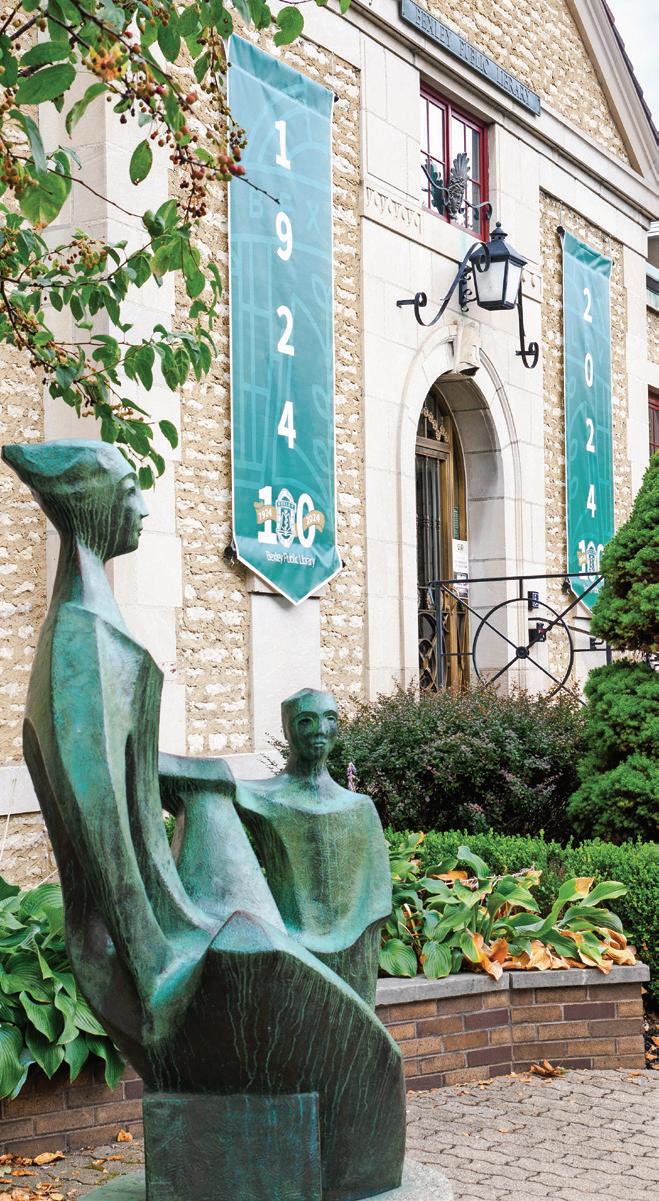
ADVERTISEMENT ADVERTISEMENT
LinkedIn Best Practices: What to Do (and What to Avoid)
DO THIS
Personalize Your Connection Requests
When sending a connection request, add a personal note explaining why you want to connect.
Example: “Hi [Name], I saw your post about [topic] and found it very insightful. I’d love to connect and learn more about your experience in [industry].”
Engage Thoughtfully with Content
Like, comment, or share posts that resonate with you, adding your own insights or questions.
Example: Commenting with “Great point, [Name]! I’ve also noticed that [additional insight]. How do you see this trend evolving?”
Share Valuable Content
Post articles, updates, or original content that provides value to your network.
Example: Share a link to a recent article you wrote or an insightful industry report with your analysis.
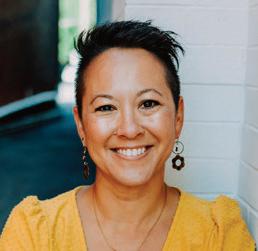
For more LinkedIn and business social media tips and strategies, please contact Jackie Murphy, Founder & Owner of Queen Bee Jackie Creative, a Columbus-based, boutique marketing agency focused on organic and personal connections.
NOT THAT
Like Without Engaging
Don’t just like posts without adding any value or commentary.
Example: Clicking “Like” on a post but not following up with a comment or share.
Post Self-Promotional Content Only
Avoid posting solely about your own achievements or products without providing value to others.
Example: “Check out my new product! Buy it now at [link].”
Ignore Messages or Delay Responses
Don’t leave messages unread or take too long to reply, giving the impression you’re unengaged or uninterested.
Example: Not responding to a message for several days or more.
Leave Your Profile Outdated
Don’t neglect to update your position, company, or accomplishments. An outdated profile can give the impression that you’re inactive or unengaged in your career.
Example: Keeping an old job title listed or not including recent achievements, making it harder for recruiters or connections to understand your current role.
614-266-2439 | queenbeepaper@gmail.com | queenbeejackie.com
The Bexley Public Library




BENEFITTING
THANKS TO OUR GENEROUS FUNDING PARTNERS, PELOTONIA IS ABLE TO DIRECT 100% OF EVERY PARTICIPANT-RAISED DOLLAR TO INNOVATIVE CANCER RESEARCH AT THE OSUCCC – JAMES.
